MyBatis-日志
# MyBatis日志模块
在Java中的日志框架也非常多,Log4j,Log4j2,Apache Commons Log,java.util.logging,slf4j等,这些工具对外的接口也都不尽相同,为了统一这些工具,MyBatis定义了一套统一的日志接口供上层使用。
# 1、Log
Log接口定义了四种日志级别
public interface Log {
boolean isDebugEnabled();
boolean isTraceEnabled();
void error(String s, Throwable e);
void error(String s);
void debug(String s);
void trace(String s);
void warn(String s);
}
2
3
4
5
6
7
8
9
10
11
12
13
14
15
16
17
# 2、LogFactory
LogFactory工厂类负责创建日志组件适配器
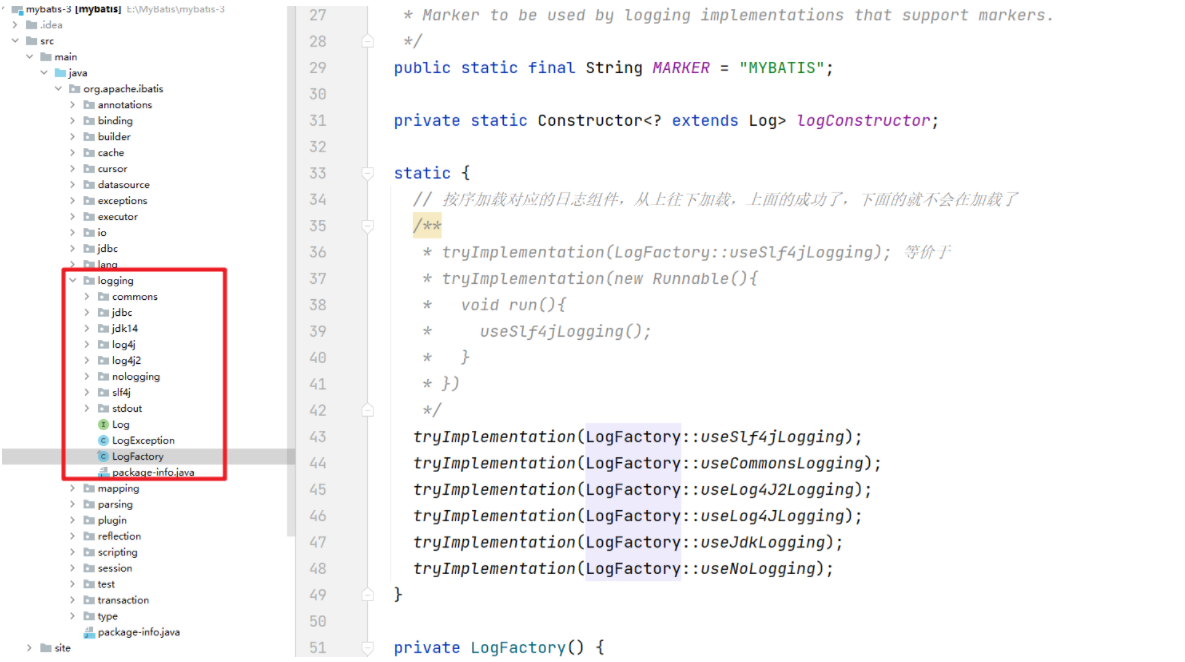
在LogFactory类加载时会执行其静态代码块,其逻辑是按序加载并实例化对应日志组件的适配器,然后使用LogFactory.logConstructor这个静态字段,记录当前使用的第三方日志组件的适配器
# 3、日志应用
那么在MyBatis系统启动的时候日志框架是如何选择的呢?首先我们在全局配置文件中我们可以设置对应的日志类型选择
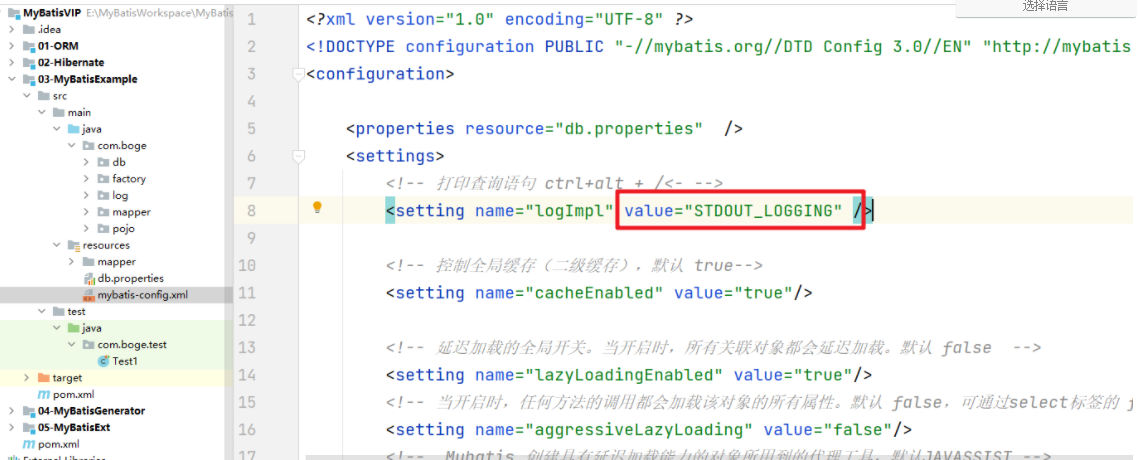
"STDOUT_LOGGING"在Configuration的构造方法中其实是设置的各个日志实现的别名的
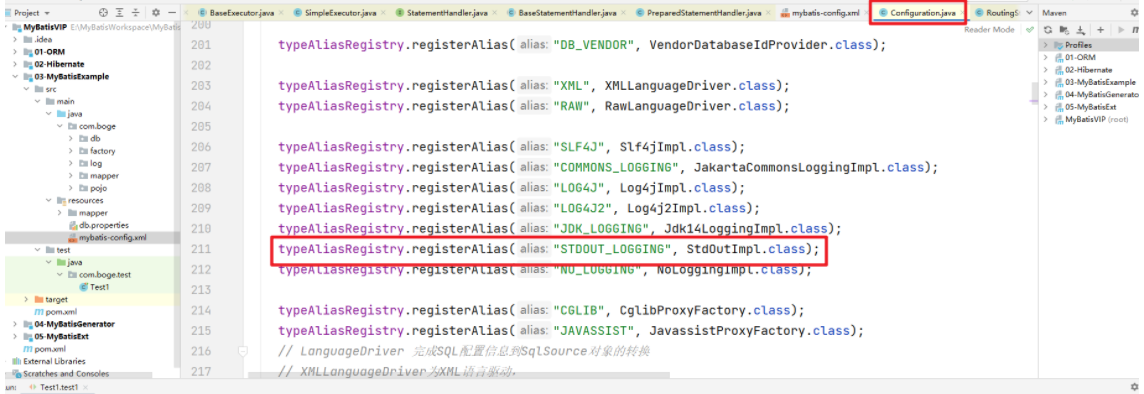
然后在解析全局配置文件的时候就会处理日志的设置
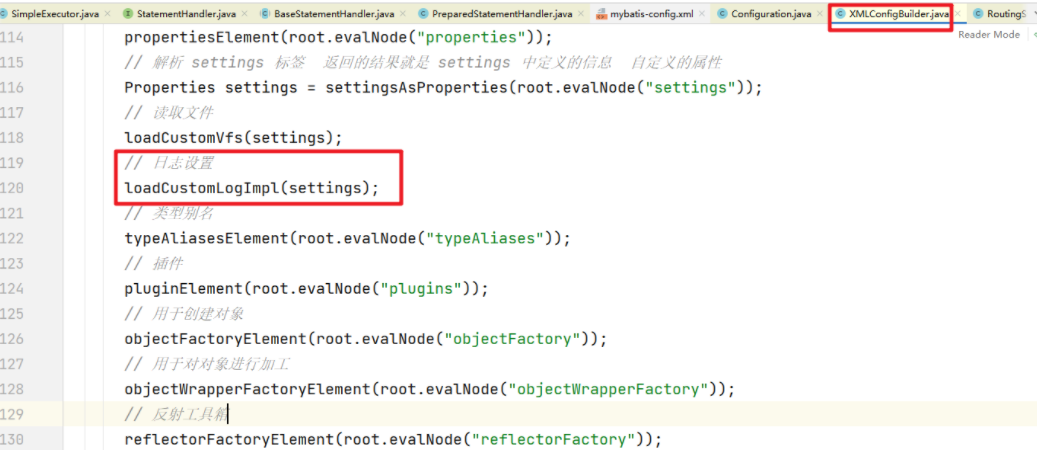
进入方法
private void loadCustomLogImpl(Properties props) {
// 获取 logImpl设置的 日志 类型
Class<? extends Log> logImpl = resolveClass(props.getProperty("logImpl"));
// 设置日志
configuration.setLogImpl(logImpl);
}
2
3
4
5
6
进入setLogImpl方法中
public void setLogImpl(Class<? extends Log> logImpl) {
if (logImpl != null) {
this.logImpl = logImpl; // 记录日志的类型
// 设置 适配选择
LogFactory.useCustomLogging(this.logImpl);
}
}
2
3
4
5
6
7
再进入
private static void setImplementation(Class<? extends Log> implClass) {
try {
// 获取指定适配器的构造方法
Constructor<? extends Log> candidate = implClass.getConstructor(String.class);
// 实例化适配器
Log log = candidate.newInstance(LogFactory.class.getName());
if (log.isDebugEnabled()) {
log.debug("Logging initialized using '" + implClass + "' adapter.");
}
// 初始化 logConstructor 字段
logConstructor = candidate;
} catch (Throwable t) {
throw new LogException("Error setting Log implementation. Cause: " + t, t);
}
}
2
3
4
5
6
7
8
9
10
11
12
13
14
15
这就关联上了我们前面在LogFactory中看到的代码,启动测试方法看到的日志也和源码中的对应上来了,还有就是我们自己设置的会覆盖掉默认的sl4j日志框架的配置
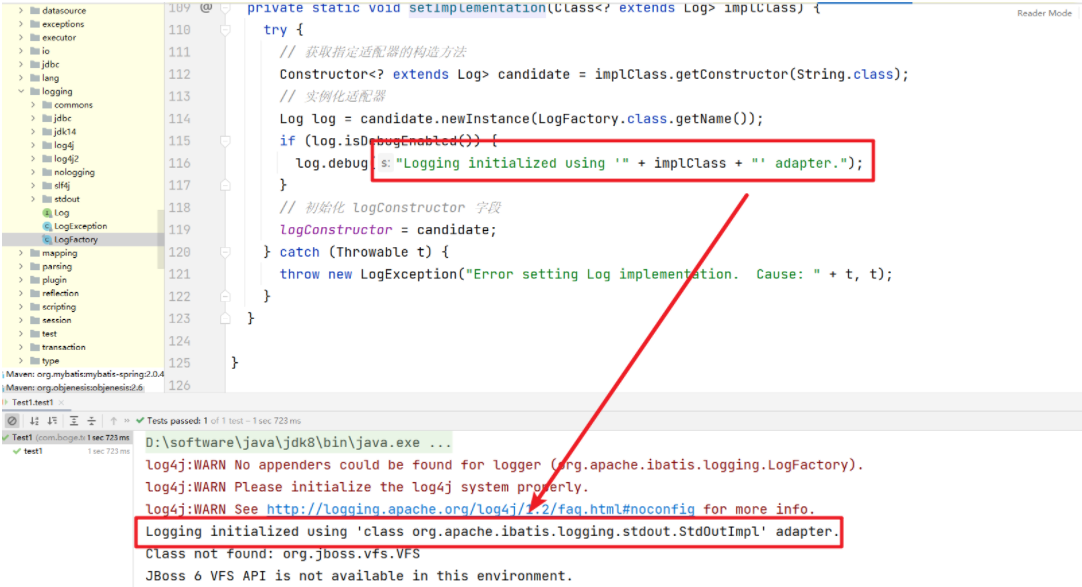
# 4、JDBC 日志
当我们开启了 STDOUT的日志管理后,当我们执行SQL操作时我们发现在控制台中可以打印出相关的日志信息
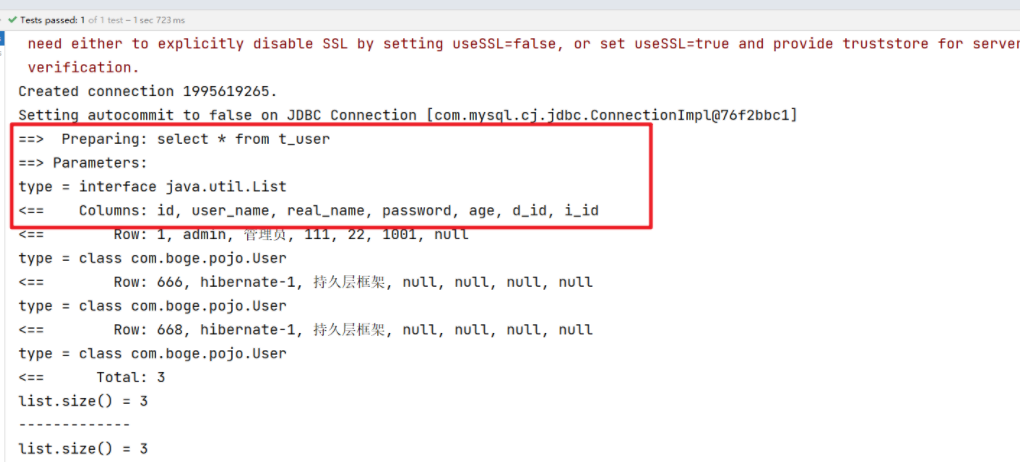
那这些日志信息是怎么打印出来的呢?原来在MyBatis中的日志模块中包含了一个jdbc包,它并不是将日志信息通过jdbc操作保存到数据库中,而是通过JDK动态代理的方式,将JDBC操作通过指定的日志框架打印出来。下面我们就来看看它是如何实现的。
# 4.1 BaseJdbcLogger
BaseJdbcLogger是一个抽象类,它是jdbc包下其他Logger的父类。继承关系如下

从图中我们也可以看到4个实现都实现了InvocationHandler接口。属性含义如下
// 记录 PreparedStatement 接口中定义的常用的set*() 方法
protected static final Set<String> SET_METHODS;
// 记录了 Statement 接口和 PreparedStatement 接口中与执行SQL语句有关的方法
protected static final Set<String> EXECUTE_METHODS = new HashSet<>();
// 记录了PreparedStatement.set*() 方法设置的键值对
private final Map<Object, Object> columnMap = new HashMap<>();
// 记录了PreparedStatement.set*() 方法设置的键 key
private final List<Object> columnNames = new ArrayList<>();
// 记录了PreparedStatement.set*() 方法设置的值 Value
private final List<Object> columnValues = new ArrayList<>();
protected final Log statementLog;// 用于日志输出的Log对象
protected final int queryStack; // 记录了SQL的层数,用于格式化输出SQL
2
3
4
5
6
7
8
9
10
11
12
13
14
# 4.2 ConnectionLogger
ConnectionLogger的作用是记录数据库连接相关的日志信息,在实现中是创建了一个Connection的代理对象,在每次Connection操作的前后我们都可以实现日志的操作。
public final class ConnectionLogger extends BaseJdbcLogger implements InvocationHandler {
// 真正的Connection对象
private final Connection connection;
private ConnectionLogger(Connection conn, Log statementLog, int queryStack) {
super(statementLog, queryStack);
this.connection = conn;
}
@Override
public Object invoke(Object proxy, Method method, Object[] params)
throws Throwable {
try {
// 如果是调用从Object继承过来的方法,就直接调用 toString,hashCode,equals等
if (Object.class.equals(method.getDeclaringClass())) {
return method.invoke(this, params);
}
// 如果调用的是 prepareStatement方法
if ("prepareStatement".equals(method.getName())) {
if (isDebugEnabled()) {
debug(" Preparing: " + removeBreakingWhitespace((String) params[0]), true);
}
// 创建 PreparedStatement
PreparedStatement stmt = (PreparedStatement) method.invoke(connection, params);
// 然后创建 PreparedStatement 的代理对象 增强
stmt = PreparedStatementLogger.newInstance(stmt, statementLog, queryStack);
return stmt;
// 同上
} else if ("prepareCall".equals(method.getName())) {
if (isDebugEnabled()) {
debug(" Preparing: " + removeBreakingWhitespace((String) params[0]), true);
}
PreparedStatement stmt = (PreparedStatement) method.invoke(connection, params);
stmt = PreparedStatementLogger.newInstance(stmt, statementLog, queryStack);
return stmt;
// 同上
} else if ("createStatement".equals(method.getName())) {
Statement stmt = (Statement) method.invoke(connection, params);
stmt = StatementLogger.newInstance(stmt, statementLog, queryStack);
return stmt;
} else {
return method.invoke(connection, params);
}
} catch (Throwable t) {
throw ExceptionUtil.unwrapThrowable(t);
}
}
/**
* Creates a logging version of a connection.
*
* @param conn - the original connection
* @return - the connection with logging
*/
public static Connection newInstance(Connection conn, Log statementLog, int queryStack) {
InvocationHandler handler = new ConnectionLogger(conn, statementLog, queryStack);
ClassLoader cl = Connection.class.getClassLoader();
// 创建了 Connection的 代理对象 目的是 增强 Connection对象 给他添加了日志功能
return (Connection) Proxy.newProxyInstance(cl, new Class[]{Connection.class}, handler);
}
/**
* return the wrapped connection.
*
* @return the connection
*/
public Connection getConnection() {
return connection;
}
}
2
3
4
5
6
7
8
9
10
11
12
13
14
15
16
17
18
19
20
21
22
23
24
25
26
27
28
29
30
31
32
33
34
35
36
37
38
39
40
41
42
43
44
45
46
47
48
49
50
51
52
53
54
55
56
57
58
59
60
61
62
63
64
65
66
67
68
69
70
71
72
其他几个xxxxLogger的实现和ConnectionLogger几乎是一样的就不在次赘述了,请自行观看。
# 4.3 应用实现
在我们要执行SQL语句前需要获取Statement对象,而Statement对象是通过Connection获取的,所以我们在SimpleExecutor中就可以看到相关的代码
private Statement prepareStatement(StatementHandler handler, Log statementLog) throws SQLException {
Statement stmt;
Connection connection = getConnection(statementLog);
// 获取 Statement 对象
stmt = handler.prepare(connection, transaction.getTimeout());
// 为 Statement 设置参数
handler.parameterize(stmt);
return stmt;
}
2
3
4
5
6
7
8
9
先进入如到getConnection方法中
protected Connection getConnection(Log statementLog) throws SQLException {
Connection connection = transaction.getConnection();
if (statementLog.isDebugEnabled()) {
// 创建Connection的日志代理对象
return ConnectionLogger.newInstance(connection, statementLog, queryStack);
} else {
return connection;
}
}
2
3
4
5
6
7
8
9
在进入到handler.prepare方法中
@Override
protected Statement instantiateStatement(Connection connection) throws SQLException {
String sql = boundSql.getSql();
if (mappedStatement.getKeyGenerator() instanceof Jdbc3KeyGenerator) {
String[] keyColumnNames = mappedStatement.getKeyColumns();
if (keyColumnNames == null) {
return connection.prepareStatement(sql, PreparedStatement.RETURN_GENERATED_KEYS);
} else {
// 在执行 prepareStatement 方法的时候会进入进入到ConnectionLogger的invoker方法中
return connection.prepareStatement(sql, keyColumnNames);
}
} else if (mappedStatement.getResultSetType() == ResultSetType.DEFAULT) {
return connection.prepareStatement(sql);
} else {
return connection.prepareStatement(sql, mappedStatement.getResultSetType().getValue(), ResultSet.CONCUR_READ_ONLY);
}
}
2
3
4
5
6
7
8
9
10
11
12
13
14
15
16
17
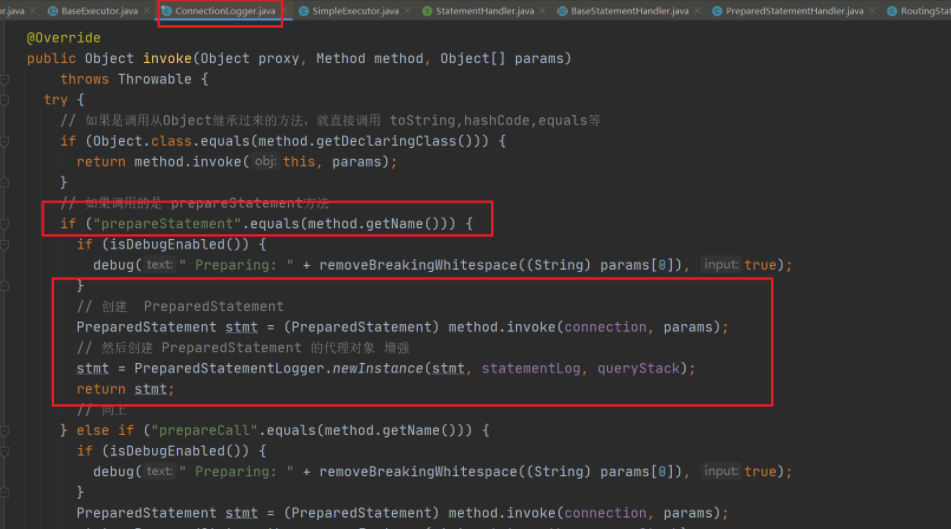
在执行sql语句的时候
@Override
public <E> List<E> query(Statement statement, ResultHandler resultHandler) throws SQLException {
PreparedStatement ps = (PreparedStatement) statement;
// 到了JDBC的流程
ps.execute(); // 本质上 ps 也是 日志代理对象
// 处理结果集
return resultSetHandler.handleResultSets(ps);
}
2
3
4
5
6
7
8
如果是查询操作,后面的ResultSet结果集操作,其他是也通过ResultSetLogger来处理的,前面的清楚了,后面的就很容易的。
